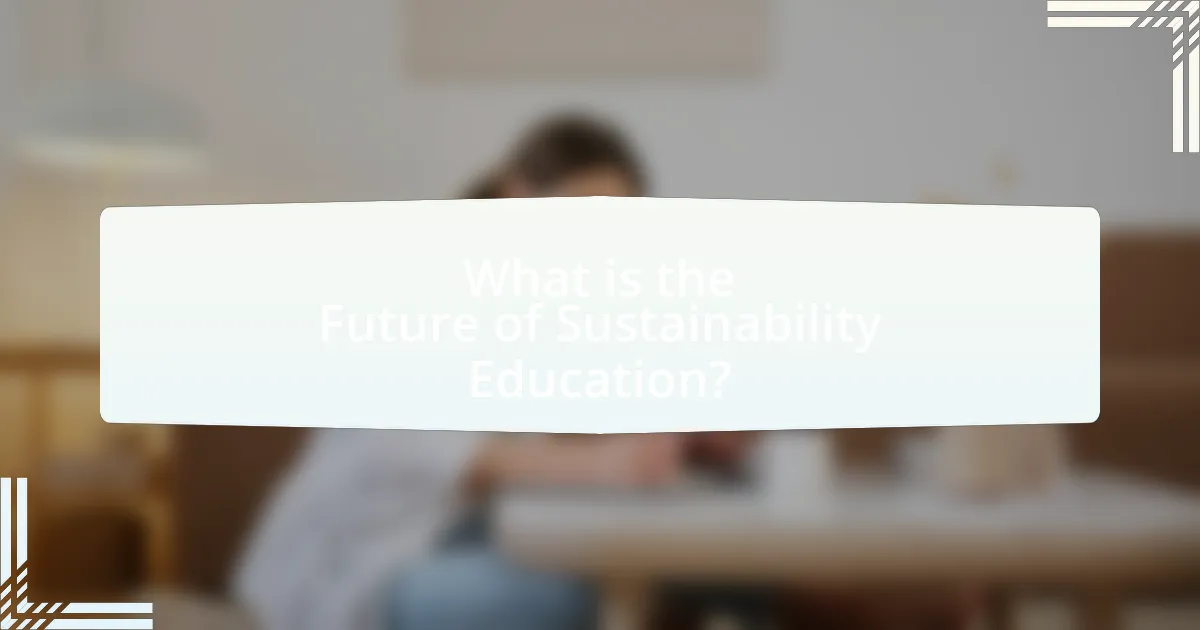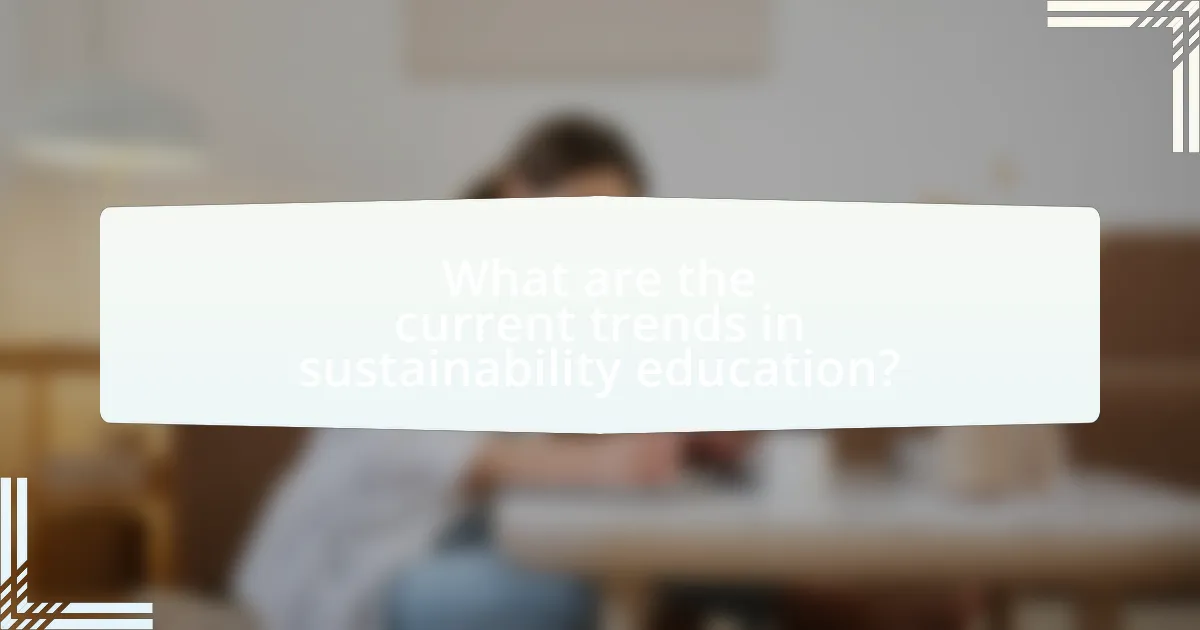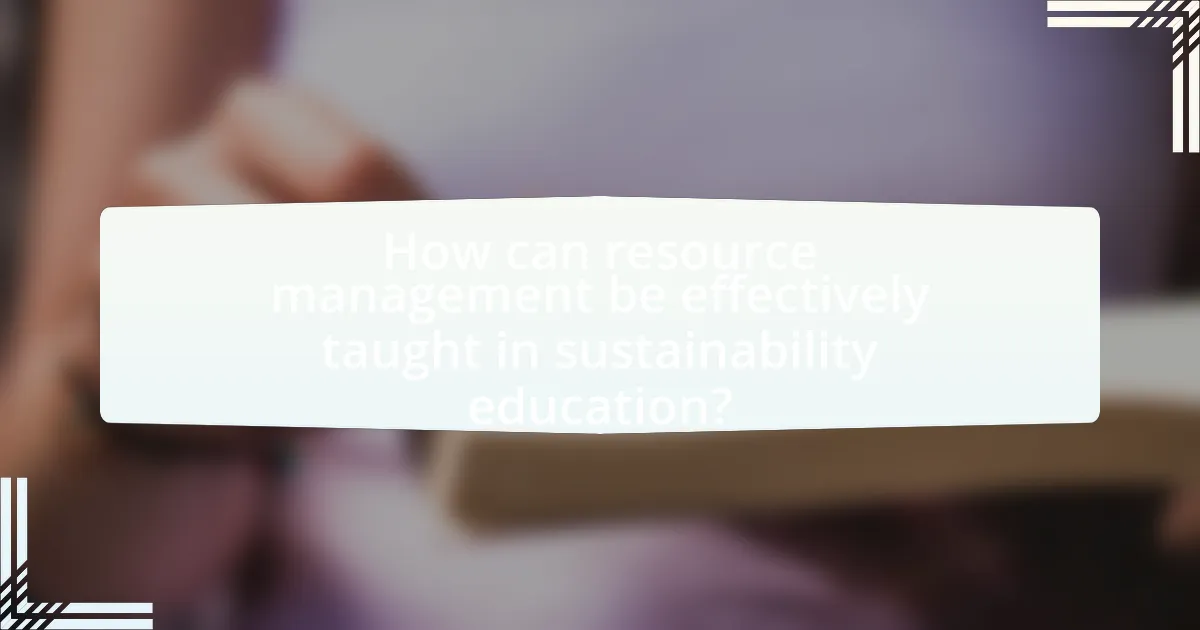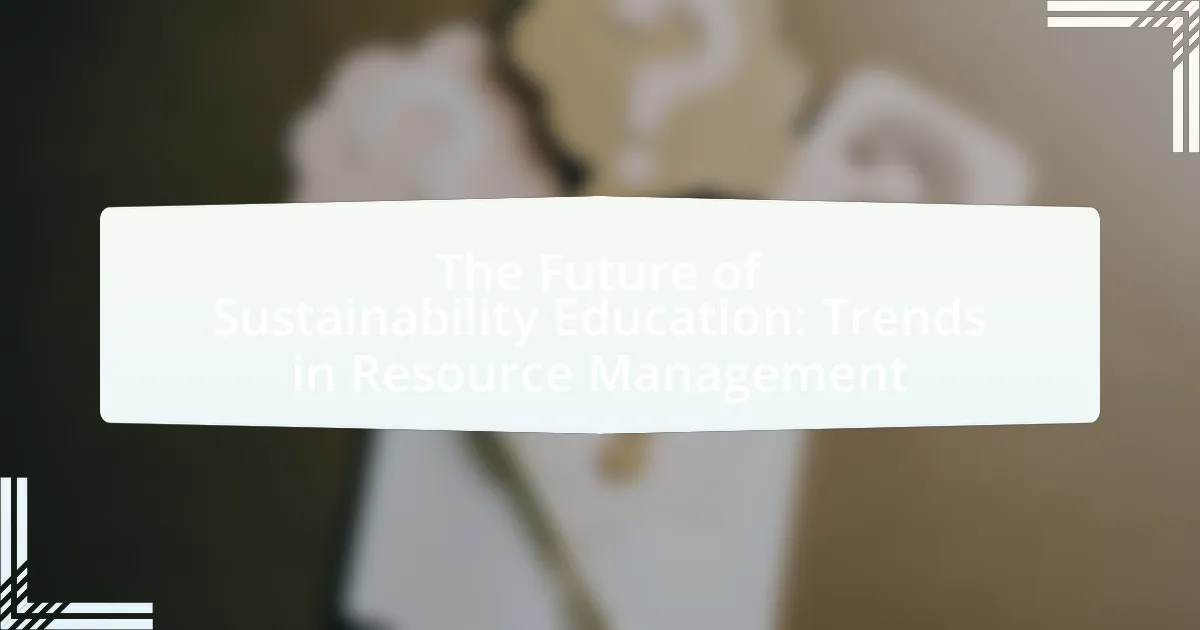The article focuses on the future of sustainability education, emphasizing the integration of interdisciplinary approaches, experiential learning, and technological advancements in resource management. It highlights the necessity for educational systems to adapt to global challenges such as climate change and social inequality, driven by the United Nations’ Sustainable Development Goals. Key drivers of change include technological innovations, policy shifts, and increased societal awareness, which collectively reshape how sustainability concepts are taught. The article also discusses best practices for teaching resource management, the importance of community partnerships, and the role of educators in fostering a culture of sustainability among students.

What is the Future of Sustainability Education?
The future of sustainability education will increasingly emphasize interdisciplinary approaches, integrating environmental science, social equity, and economic viability. This shift is driven by the growing recognition that sustainable practices require a holistic understanding of complex systems. For instance, the United Nations’ Sustainable Development Goals highlight the necessity for education systems to adapt and prepare students for challenges related to climate change, resource depletion, and social justice. Furthermore, research indicates that experiential learning, such as community-based projects and hands-on activities, will become central to curricula, fostering practical skills and critical thinking. As a result, sustainability education will evolve to not only impart knowledge but also empower students to take actionable steps towards a sustainable future.
How is sustainability education evolving in response to global challenges?
Sustainability education is evolving by integrating interdisciplinary approaches and practical applications to address global challenges such as climate change, resource depletion, and social inequality. Educational institutions are increasingly incorporating real-world problem-solving into curricula, emphasizing collaboration across disciplines like environmental science, economics, and social justice. For instance, programs now often include experiential learning opportunities, such as community projects and partnerships with local organizations, which enhance students’ understanding of sustainability in practice. This shift is supported by research indicating that hands-on, collaborative learning significantly improves student engagement and retention of sustainability concepts, as highlighted in the 2021 report by the United Nations Educational, Scientific and Cultural Organization (UNESCO) on Education for Sustainable Development.
What are the key drivers of change in sustainability education?
The key drivers of change in sustainability education include technological advancements, policy shifts, and societal awareness. Technological advancements, such as online learning platforms and interactive tools, enhance accessibility and engagement in sustainability topics. Policy shifts, including international agreements like the Paris Agreement, push educational institutions to integrate sustainability into their curricula. Societal awareness, driven by climate change activism and public discourse, compels educational systems to prioritize sustainability education to prepare future generations for environmental challenges. These factors collectively reshape how sustainability is taught and understood in educational contexts.
How do technological advancements influence sustainability education?
Technological advancements significantly enhance sustainability education by providing innovative tools and platforms for learning. These advancements facilitate access to real-time data, enabling students and educators to analyze environmental impacts and resource management more effectively. For instance, the use of simulation software allows learners to model ecological systems and understand the consequences of various sustainability practices. Additionally, online learning platforms and mobile applications expand educational reach, making sustainability concepts accessible to a broader audience. Research indicates that integrating technology in education improves engagement and retention rates, as seen in studies conducted by the National Education Association, which found that technology-enhanced learning environments lead to higher student achievement.
Why is resource management a critical component of sustainability education?
Resource management is a critical component of sustainability education because it equips individuals with the skills to efficiently utilize and conserve natural resources. Effective resource management directly impacts environmental sustainability by promoting practices that reduce waste, enhance resource efficiency, and support ecosystem health. For instance, studies show that implementing sustainable resource management practices can lead to a 30% reduction in resource consumption in various sectors, thereby mitigating environmental degradation and fostering long-term ecological balance.
What role does resource management play in achieving sustainability goals?
Resource management is crucial for achieving sustainability goals as it ensures the efficient use and conservation of natural resources. Effective resource management minimizes waste, reduces environmental impact, and promotes the sustainable use of resources, which is essential for maintaining ecological balance. For instance, the United Nations’ Sustainable Development Goals emphasize responsible consumption and production patterns, highlighting the importance of resource management in addressing global challenges such as climate change and biodiversity loss. By implementing strategies like recycling, renewable energy use, and sustainable agriculture, resource management directly contributes to the realization of these sustainability objectives.
How can effective resource management practices be integrated into educational curricula?
Effective resource management practices can be integrated into educational curricula by incorporating hands-on projects, interdisciplinary approaches, and real-world case studies. Schools can implement project-based learning where students engage in activities that require them to manage resources, such as budgeting for a school event or developing a sustainability plan for their community. Interdisciplinary approaches can connect subjects like science, economics, and social studies to teach students about the importance of resource management in various contexts. Additionally, using real-world case studies, such as analyzing local environmental issues or successful sustainability initiatives, can provide students with practical insights into effective resource management. These methods have been shown to enhance student engagement and understanding, as evidenced by studies indicating that experiential learning significantly improves retention and application of knowledge in resource management.

What are the current trends in sustainability education?
Current trends in sustainability education include an increased emphasis on interdisciplinary approaches, experiential learning, and the integration of technology. Interdisciplinary approaches combine insights from various fields such as environmental science, economics, and social studies, fostering a holistic understanding of sustainability challenges. Experiential learning, such as hands-on projects and community engagement, enhances student involvement and practical application of sustainability concepts. Additionally, the integration of technology, including online platforms and digital resources, facilitates access to information and collaborative learning experiences. These trends are supported by research indicating that such methods improve student engagement and retention of sustainability principles.
How are interdisciplinary approaches shaping sustainability education?
Interdisciplinary approaches are shaping sustainability education by integrating diverse fields such as ecology, economics, and social sciences to create a holistic understanding of sustainability challenges. This integration fosters critical thinking and problem-solving skills among students, enabling them to address complex environmental issues effectively. For instance, programs that combine environmental science with policy studies prepare students to analyze the implications of legislation on natural resources, as evidenced by the success of interdisciplinary curricula at institutions like Stanford University, where students engage in projects that require collaboration across disciplines. Such educational frameworks not only enhance knowledge retention but also promote innovative solutions to sustainability problems, demonstrating the effectiveness of interdisciplinary methods in preparing future leaders in resource management.
What subjects are being integrated into sustainability education programs?
Sustainability education programs are integrating subjects such as environmental science, economics, social justice, and policy studies. These subjects provide a comprehensive understanding of sustainability by addressing ecological, economic, and social dimensions. For instance, environmental science equips students with knowledge about ecosystems and biodiversity, while economics focuses on sustainable resource management and the impact of economic activities on the environment. Social justice emphasizes equity and community engagement, and policy studies explore the frameworks necessary for implementing sustainable practices. This multidisciplinary approach is essential for developing effective solutions to complex sustainability challenges.
How does collaboration between disciplines enhance learning outcomes?
Collaboration between disciplines enhances learning outcomes by integrating diverse perspectives and expertise, which fosters critical thinking and innovation. When students engage in interdisciplinary projects, they are exposed to various methodologies and problem-solving approaches, leading to a deeper understanding of complex issues. For instance, a study published in the Journal of Environmental Education Research found that interdisciplinary learning environments significantly improved students’ ability to apply knowledge in real-world contexts, demonstrating that collaboration can lead to more effective and holistic educational experiences.
What innovative teaching methods are being adopted in sustainability education?
Innovative teaching methods being adopted in sustainability education include experiential learning, project-based learning, and interdisciplinary approaches. Experiential learning engages students through hands-on activities, allowing them to apply theoretical knowledge in real-world contexts, which has been shown to enhance retention and understanding of sustainability concepts. Project-based learning encourages students to work on sustainability projects that address local environmental issues, fostering critical thinking and collaboration skills. Interdisciplinary approaches integrate knowledge from various fields, such as ecology, economics, and social sciences, to provide a holistic understanding of sustainability challenges. These methods are supported by research indicating that active learning strategies significantly improve student engagement and outcomes in sustainability education.
How does experiential learning contribute to sustainability education?
Experiential learning significantly enhances sustainability education by providing hands-on experiences that foster critical thinking and problem-solving skills related to environmental issues. This approach allows learners to engage directly with real-world challenges, such as resource management and ecological conservation, thereby deepening their understanding of sustainability concepts. Research indicates that students who participate in experiential learning programs demonstrate improved retention of knowledge and a greater commitment to sustainable practices, as evidenced by a study published in the Journal of Environmental Education, which found that 85% of participants reported a stronger connection to environmental stewardship after engaging in experiential activities.
What role do online platforms play in delivering sustainability education?
Online platforms serve as crucial tools for delivering sustainability education by providing accessible, diverse, and interactive learning resources. These platforms enable learners from various backgrounds to engage with sustainability concepts through courses, webinars, and forums, fostering a global community focused on environmental issues. For instance, platforms like Coursera and edX offer specialized courses on sustainability topics, reaching millions of users worldwide and contributing to a more informed public. Additionally, online platforms facilitate collaboration among educators, researchers, and practitioners, enhancing the quality and relevance of sustainability education through shared knowledge and resources.

How can resource management be effectively taught in sustainability education?
Resource management can be effectively taught in sustainability education through experiential learning, case studies, and interdisciplinary approaches. Experiential learning allows students to engage in real-world projects that require resource allocation and management, fostering practical skills. Case studies provide concrete examples of successful resource management strategies, enabling students to analyze and apply these concepts in various contexts. Interdisciplinary approaches integrate knowledge from economics, ecology, and social sciences, offering a holistic understanding of resource management challenges. Research indicates that programs incorporating these methods lead to higher retention of knowledge and better application of skills in real-life scenarios, as evidenced by studies conducted by the National Academy of Sciences, which highlight the effectiveness of hands-on learning in environmental education.
What are the best practices for teaching resource management?
The best practices for teaching resource management include integrating real-world applications, promoting collaborative learning, and utilizing technology effectively. Real-world applications, such as case studies and simulations, help students understand the practical implications of resource management decisions. Collaborative learning encourages teamwork and problem-solving skills, essential for managing resources in diverse environments. Utilizing technology, such as data analytics tools and online platforms, enhances engagement and provides students with modern skills relevant to the field. These practices are supported by educational research indicating that experiential learning and collaboration significantly improve retention and application of knowledge in resource management contexts.
How can case studies be utilized to enhance understanding of resource management?
Case studies can enhance understanding of resource management by providing real-world examples that illustrate the complexities and challenges involved in managing resources effectively. They allow learners to analyze specific situations, evaluate decision-making processes, and understand the outcomes of various management strategies. For instance, a case study on water resource management in California highlights the impact of drought and the effectiveness of conservation measures, demonstrating how theoretical concepts apply in practice. This practical application of knowledge helps students and professionals grasp the nuances of resource management, fostering critical thinking and problem-solving skills essential for sustainability.
What tools and resources are available for educators in this field?
Educators in the field of sustainability education can access various tools and resources, including online platforms, curriculum guides, and interactive software. For instance, platforms like EcoSchools provide comprehensive resources for integrating sustainability into school curricula, while the United Nations Educational, Scientific and Cultural Organization (UNESCO) offers guidelines and materials for educators focused on sustainable development. Additionally, software tools such as GIS (Geographic Information Systems) enable educators to teach resource management through spatial analysis, enhancing students’ understanding of environmental data. These resources are validated by their widespread use in educational institutions and their alignment with global sustainability goals.
What challenges do educators face in teaching sustainability and resource management?
Educators face several challenges in teaching sustainability and resource management, primarily due to a lack of resources, insufficient training, and varying levels of student engagement. Limited access to updated materials and technology hinders the ability to provide comprehensive education on sustainability practices. Additionally, many educators have not received adequate training in sustainability concepts, which affects their confidence and effectiveness in teaching the subject. Research indicates that only 30% of teachers feel prepared to teach sustainability topics, highlighting a significant gap in professional development. Furthermore, students’ varying interests and motivations can lead to inconsistent engagement, making it difficult for educators to foster a deep understanding of sustainability and resource management principles.
How can educators overcome barriers to effective teaching in sustainability education?
Educators can overcome barriers to effective teaching in sustainability education by integrating interdisciplinary approaches and utilizing experiential learning methods. Interdisciplinary approaches allow educators to connect sustainability concepts across various subjects, enhancing relevance and engagement. For instance, incorporating environmental science with economics can provide students with a comprehensive understanding of resource management. Experiential learning, such as field trips or community projects, enables students to apply theoretical knowledge in real-world contexts, fostering deeper understanding and retention. Research indicates that hands-on experiences significantly improve student engagement and learning outcomes in sustainability education, as evidenced by studies showing increased student motivation and knowledge retention when involved in practical applications of sustainability concepts.
What support systems are necessary for educators to succeed?
Support systems necessary for educators to succeed include professional development, mentorship programs, access to resources, and collaborative networks. Professional development equips educators with the latest teaching strategies and sustainability practices, which is essential in a rapidly evolving field like sustainability education. Mentorship programs provide guidance and support from experienced educators, fostering a culture of continuous improvement. Access to resources, such as teaching materials and technology, enhances educators’ ability to deliver effective lessons. Collaborative networks allow educators to share best practices and experiences, promoting innovation and collective problem-solving in resource management. These support systems are critical for fostering an environment where educators can thrive and effectively teach sustainability concepts.
What practical steps can be taken to improve sustainability education?
To improve sustainability education, integrating experiential learning opportunities into curricula is essential. This approach allows students to engage in hands-on projects, such as community gardens or renewable energy installations, which enhance understanding of sustainability concepts. Research indicates that experiential learning significantly increases retention of knowledge and fosters a deeper connection to environmental issues (Kolb, 1984). Additionally, incorporating interdisciplinary studies that connect sustainability with economics, social sciences, and technology can provide a more holistic view, preparing students for real-world challenges. Studies show that interdisciplinary education promotes critical thinking and problem-solving skills, which are vital for addressing complex sustainability issues (Beers, 2011).
How can institutions foster a culture of sustainability among students?
Institutions can foster a culture of sustainability among students by integrating sustainability into the curriculum and promoting hands-on experiences. By incorporating sustainability topics across various subjects, institutions ensure that students understand the importance of environmental stewardship. For instance, research from the Journal of Cleaner Production indicates that educational programs emphasizing sustainability lead to increased student awareness and engagement in sustainable practices. Additionally, institutions can create sustainability-focused clubs and initiatives, encouraging students to participate in projects that promote eco-friendly behaviors, such as recycling programs and community gardens. These actions not only educate students but also empower them to take ownership of sustainability efforts within their communities.
What role do community partnerships play in enhancing sustainability education?
Community partnerships play a crucial role in enhancing sustainability education by providing real-world contexts and resources that enrich learning experiences. These collaborations enable educational institutions to connect with local organizations, businesses, and government entities, facilitating the sharing of knowledge and expertise. For instance, partnerships with environmental organizations can offer students hands-on opportunities to engage in sustainability projects, such as community gardens or recycling initiatives, which have been shown to increase student engagement and understanding of ecological principles. Research indicates that students involved in community-based sustainability projects demonstrate improved critical thinking skills and a greater sense of environmental stewardship, as evidenced by studies conducted by the National Environmental Education Foundation.

Leave a Reply